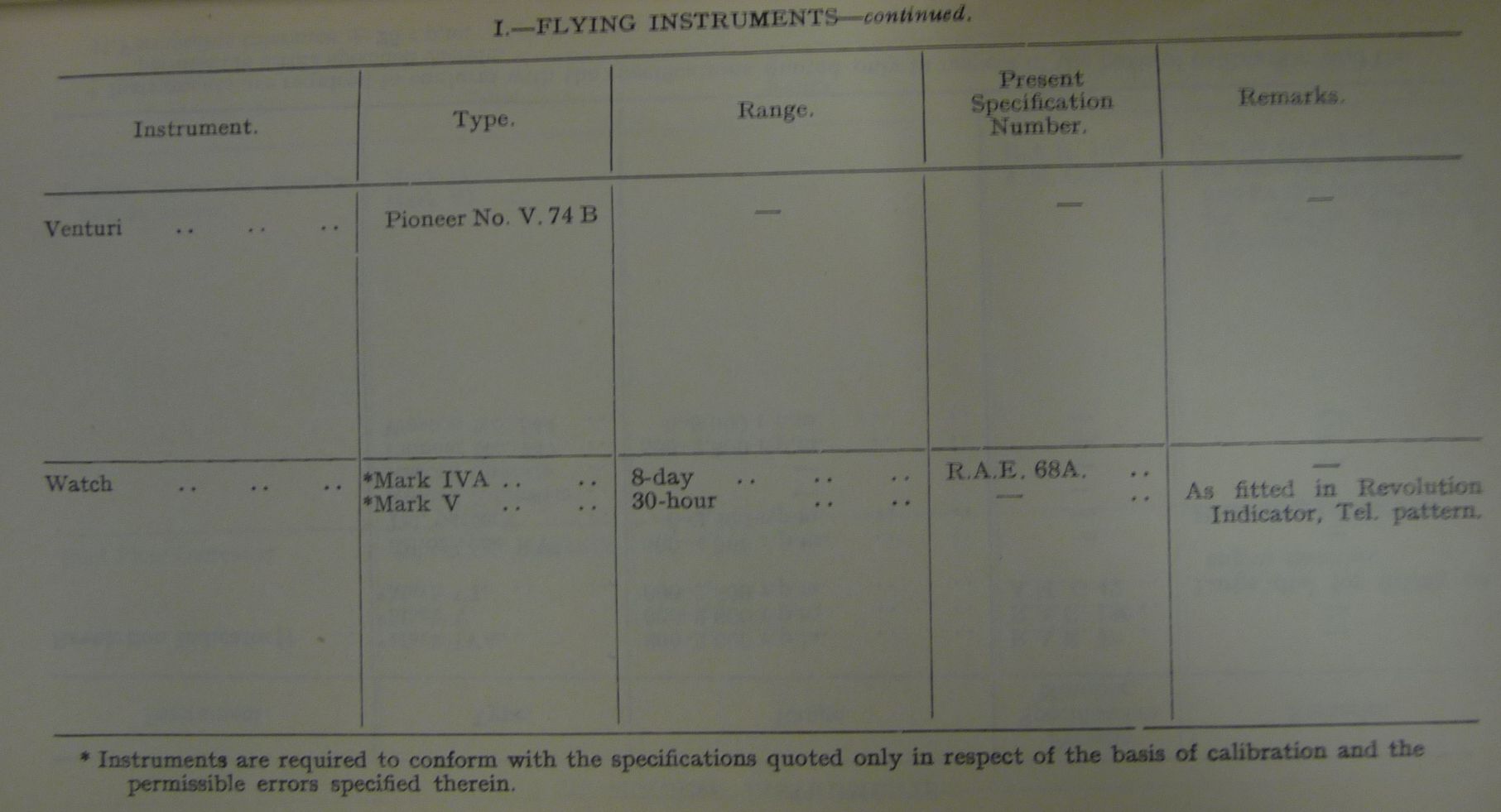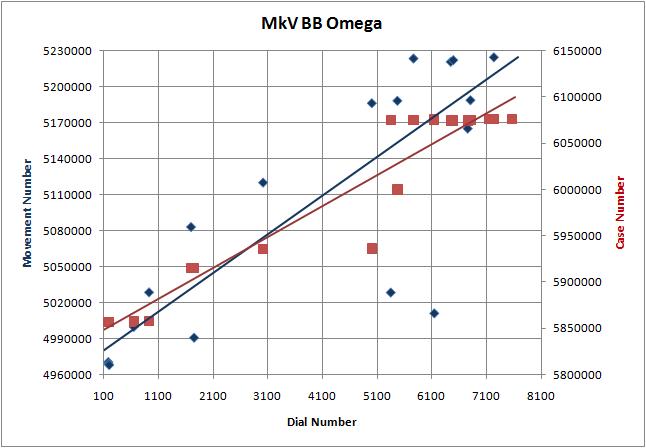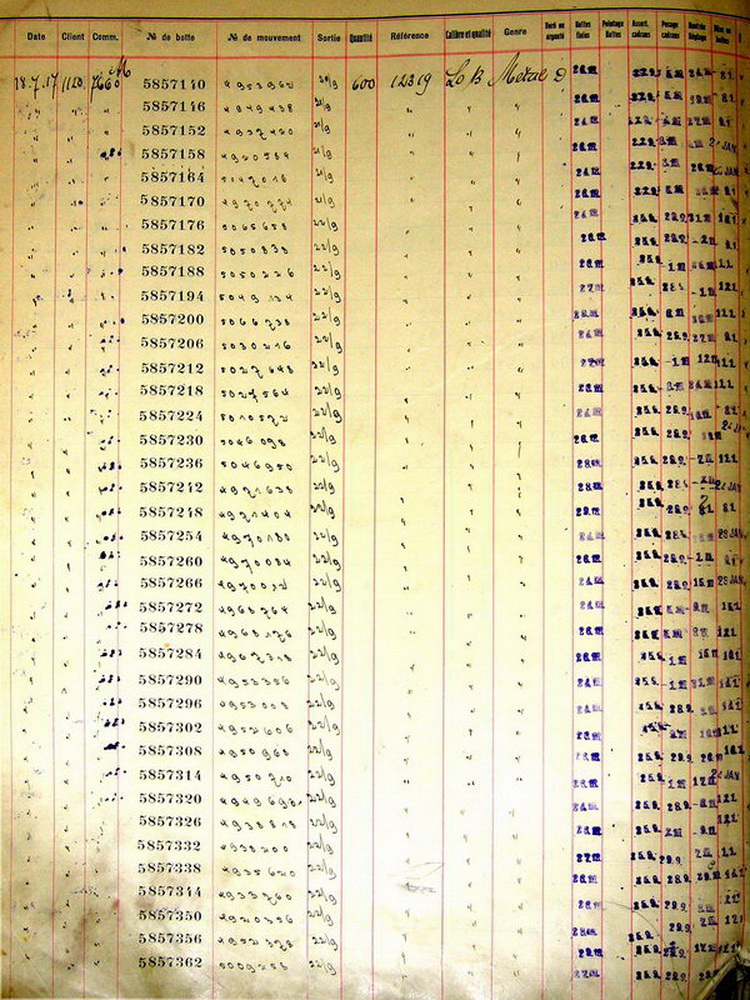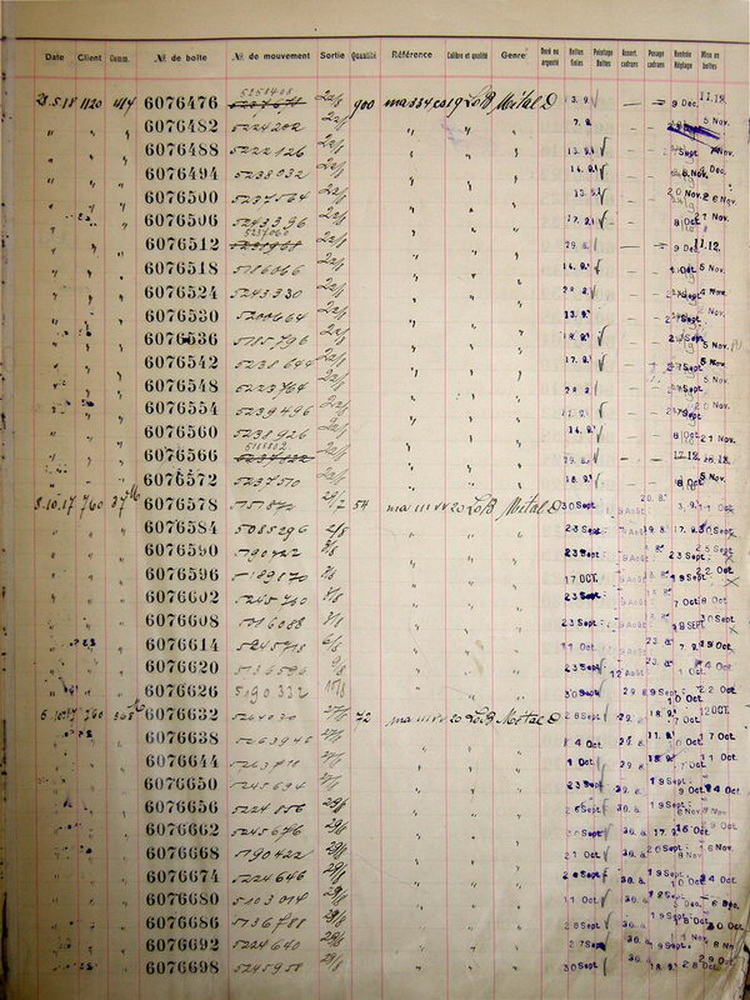
| WWT Shows | CLICK TO: Join and Support Internet Horology Club 185™ | IHC185™ Forums |

|
• Check Out Our... • • TWO Book Offer! • |
Welcome Aboard IHC185™  Internet Horology Club 185
Internet Horology Club 185  IHC185™ Discussion Site Main Page
IHC185™ Discussion Site Main Page  Horological Discussions, Questions and Answers
Horological Discussions, Questions and Answers  Military Timepiece Discussions - EXCLUSIVE!
Military Timepiece Discussions - EXCLUSIVE!  RFC Aircraft Watches - Mark V Letter Codes
RFC Aircraft Watches - Mark V Letter Codes
 Internet Horology Club 185
Internet Horology Club 185  IHC185™ Discussion Site Main Page
IHC185™ Discussion Site Main Page  Horological Discussions, Questions and Answers
Horological Discussions, Questions and Answers  Military Timepiece Discussions - EXCLUSIVE!
Military Timepiece Discussions - EXCLUSIVE!  RFC Aircraft Watches - Mark V Letter Codes
RFC Aircraft Watches - Mark V Letter CodesGo  | New Topic  | Find-Or-Search  | Notify  | Tools  | Reply to Post  |  |
Hello John, Thanks for your continued interest in the Elliott Brothers watch. The Admiralty Mark II (at least) is a well-established watch issued quite separately from the Mark IVAs and Mark Vs. My private theory is that the A^D mark relates to the Air Department of the Admiralty which only existed for a short time (1912-1914). I initially thought that the watch pictured above was a Mark II because the dial is not worn but there is an unfortunate small chip by the marking. It is so placed that any remnants of a second 'I' should still be visible, however. (A second 'I' would also unbalance the marking which lines up exactly with 'London' above as it stands). I have seen only one other Elliott Bothers watch that I would trust as 'original and issued' and it was undoubtedly marked 'Admiralty Mark I'. It may be that Elliott Brothers alone supplied the Mark I. (This firm supplied altimeters and other instruments for the War Department and Admiralty and the Be2c in the Imperial War Museum in London has a full instrument panel clearly and distinctively marked 'Elliott', with space for a watch at its summit). I have seen a few Admiralty Mark IVAs (marked Luminous or Non-Luminous)and these have had the Octava movement but no suppliers details to the dial because they were marked A.G. (Another pet theory of mine is that the A.G. (Mark IVA) and B.G. (Mark V) serials indicate redialled and reissued watches, an 8-day Mark V being anomalous). Regarding the odd Elliott Brothers Mark IVAs, I would agree with the tendencies of Jim H's thoughts above. I would interested to know if the nomenclature on these watches was painted on or was part of the porcelain dial's design. The latter would indicate complete originality; the former would raise the possibility of a redial or refinish. All this is not helped of course by the fact that the Octava watches are all indistinguishable apart from the nomenclature that appears on the dials. As you hinted earlier, I think some information could be obtained from looking at the Octava movement serial numbers which seem to group together in batches (by mark and by supplier) from the small sampling I have made. The only previous Elliott Brothers Mark IVA I bothered to note (no issue details) had an Octava movement with serial number 54608 (which is consistent with the latest ebay example). The two Admiralty Mark Is have serial numbers in the 53xxx range as far as my notes indicate, so are earlier. The other Octava Mark IVAs tend to start in the 58xxx range and go up to 70xxx, again as far as my notes indicate. (Interestingly, the unique luminous Mark IVA supplied by Alexander & Son with the A^S (RNAS) case back marking may have been one of the very first batches with a 58xxx serial). Maybe we should start a thread to record Ocatava serial numbers for Mark IVAs and Mark Vs? Hope this is useful. Regards, Martin | ||||
|
Here is another piece to the puzzle. I knew I had seen somewhere offical what the Mk V was intended for in civil use. The Mk IVA has it's specification doucument stated but the Mk V does not. The Mk V is stated as "As fitted in Revolution Indicator, Tel. pattern". This has been taken from AP1208, the Air Ministry publication titled - "Airworthiness Handbook for Civil Aircraft".  | ||||
|
The details of the revolution indicator are given in a design leaflet under Engine Instruments. Type: Tel. pattern Range: 0-2,500 r.p.m. Present Specification number: nil stated Remarks: Recording Instrument The details at the bottom of the page read: Instruments are required to conform with the specifications quoted only in respect of the basis of calibration and the permissible errors specified therein. Permissible tolerance ± 25 r.p.m. | ||||
|
Thanks for the good information, Craig! Do you have any information or references on the Mark I, Mark II, Mark III and Mark IV watches that must have come before the Mark IVA and Mark V watches? | ||||
|
Jim I have the specification stated in the image above. RAF68A later renamed RAE68A. I have quoted from it in earlier posts in this thread. It gives the drawing numbers as well. I have not located the drawings however. It also states how the serial numbers are to be allocated. Konrad has reprodued a page of this specification in his book. I have been searching for a specification for the Mk V for some time but no results to date. The above document did not help but finding out about the revolution indicator could reveal some clues. In relation to the earlier Marks, I and II etc, I am starting to think I may have to look at naval sources to get information on them. It's not an area of research I have really looked into. It's just a part of the big puzzle which one day I will work out. | ||||
|
Craig: Just a thought on a related tack: I don't know whether it's been observed before but I wonder if there's any significance in the existence of the 'Zenith Mark VA Altimeter (Non-Luminous)', which has been attributed to RFC aircraft by militaria dealers on occasion? This nomenclature is very close to that seen on Mark IVA and Mark V watches and, more intriguing still, the dial of the Zenith altimeter carried issue codes of the form, eg: No 11925/W; No 13322/W; No 14318/W; or No 31597/W (W being, of course, the Mark IVA letter code for Favre-Jacot aka Zenith). It seems possible that the letter codes are not limited to watches and may appear on other instruments so maybe the wider population of WWI militaria collectors has info on them (not that I know any personally). This may also explain the apparent 'gaps' in the codes observed on the watches. For reference: here's a photo of the Be2c Elliott-marked instrument panel in the IWM. The plane has a good history (RFC) but I don't know how much restoration was undertaken on it - I wouldn't trust that watch to be original, for instance....  Regards, Martin | ||||
|
Martin That is how the serial number system works. Look back in the posts and you will see that I talked about this 3 years ago. The same letters in a serial number are used for a given manufacturer reqardless of the product they supply. | ||||
|
Craig, Thanks for the pointer. I'm sure I had read the post at some point. The possibility that arose in my mind is more that some collector of WWI instruments (as opposed to watches alone) might have a comprehensive list of instrument codes that could put the watch codes into some wider context (and even possibly explain the parallel system of single letter codes and two-letter codes seen on the Mark IVAs). Thanks again and regards, Martin | ||||
|
Perhaps the Marks I through IV are not related to aircraft timepieces? | ||||
|
Regarding the supply of MkV watches by Omega I note that two people have received certification from Omega Archives; Curiously, both watches were supplied on the same date, yet have quite different serial numbers... BB929 Delivered 18 July 1917 BB5205 Delivered 18 July 1917 I reckon Omega dial numbers run from BB100 up to approx BB7700... were they all issued as a single delivery?? Might this support the theory that there were far fewer made (100s rather than 1000s per manufacturer)? Conversely, higher dial numbers are generally found on higher movement numbers, which would suggest staged/batched deliveries (unless Omega allocated and painted on the dial numbers)? I have a list of 50+ Omega MkVs of which I have movement/case numbers for 20 of them. Unfortunately I have no details for BB5205. The movement number for BB929 (5028746) ties in very well with other watches.  | ||||
|
Anything is possible but I would think that a simpler answer is more likely since it makes no sense to me that they would skip serial numbers. In my thinking the guys at Omega who are responding to recent requests may not have high quality records from that long ago and they have just one date, perhaps the contract date, that they give out when people ask them for such a date for any watches in this group they made. After all, about 8,000 watches was a relatively modest number of timepieces for a company that made millions of watches. Another reason I think this is the case is the shear number of these that are constantly coming on the market. They are one of the most common of the Mark V watches that you see on Ebay and other sales sites and this does not account for all of them in people's collections which is unknowable. If only a few hundred were made, it makes no sense to me that there would be so many of them being sold 95 years later considering that some would have been detroyed in combat and more would have fallen apart or worn out and were thrown away in the intervening years. For there to be so many seen on the market today, I think that there would have had to have been a very large number made and delivered back in the day. | ||||
|
Bruce: I think it's valuable for you to keep assembling these data. I wonder incidentally whether you have seen the Omega records reproduced in Konrad Knirim's book (pp 403 and 541)? These do not show the B.B. numbers, unfortunately, but they are interesting otherwise. They show, for instance, that Omega indexes its 1917/18 records according to case number. The movement numbers show little ordering or consistency by comparison (49xxxxx-50xxxxx shown for the July 1917 order; 51xxxxx-52xxxxx shown for the May 1918 order). Of course this proves only that the cases and movements were not put together in strict order off the production lines. The date of 18 July 1917 is shown as the first entry of each record on p 403. This is likely to be the date of the ORDER (as Jim H surmises) and the first order appears to consist of 600 pieces (employing the silvered dial). There are numerous entries to the right hand side of each entry recording various operations involving the case and dial dating from September 1917 onwards until 'mise en boites' (meaning 'put into [packing] boxes', I presume, rather than 'cased') in January 1918. A date of 28 May 1918 is shown as the order date for each record on p 541 and the batch appears to consist of 900 pieces (but now employing the dial with bold white numerals). These are shown as 'mise en boites' in November and December 1918. Two things occur: (1) the Omega records show at least two separate batches of 600 and 900 pieces (== 1500) - this must be the bare minimum of Omega Mark Vs delivered; (2) the reason for the high survivability of Omega Mark Vs (if not all Mark Vs) is that they were issued only from 1918 onwards and saw most service during the inter-war period. (I know this is one of my pet hobby horses but it explains much). Hope this helps. Regards, Martin | ||||
|
Hello First post, so be gentle with me I am not a collector of watch's, but have this time piece and would like to find out a bit more about it. I will probably sell it if it is worth getting repaired. The problem is apart from the broken glass, it is not ticking and can not be wound up. I have no idea of its worth and fully appreciate that this forum is not an evaluation site. Any help greatly appreciated. Regards. Dave. I know its an Omega Case number is 5857220 Number on the moving bits 5027566 also has omega on it. The dial has BB547 30 hour non luminous MK V    | ||||
|
Hello Barry, Welcome! Barry, my opionion is....if you like a watch and want to see it running again, make it happen! Sometimes this is impossible due to the extent of a repair or damage. Your watch unfortunatly is common. Omega being a reputable watch house, their timepieces are always thought to be more desirable just on the name alone. But Omega made made one of the largest percentages of the Mark V watch during this era. The value of these peices is wide and that range is determined what is available on the market at this momment and its condition. Condition can be determined by its running status, case and movement condition and military markings clarity. Your peice has the markings it should and things look all "ok" to me. It does not look like two or three watches combined to make one. Value ranges from $200-????. Sorry for the ???? but this range is determined like I stated before its condition ans rarity. Unfortunatly in your case, Omega is quite common. This thread has a great deal of information on this type watch including other Mark cockpit watches. Jim Hester struck gold when starting this thread. Lots of great info here. If you like the watch, and want to keep it for yourself in your collection- fix it. But sometimes the cost outways the final value and it is just not good buisness to invest. That is what you will have to determine. Same style thick glass crystals are not that hard to locate and sometimes the winding issue is a simple fix and sometimes not. I am far from any knowledge of watch repair. Maybe Jim Hester can elaborate with more information. Welcome again! Nice people and goos information here. I have made more than one good friend in becoming a member of IHC 185. Regards, nice watch. Mike | ||||
|
As Michael points out, the Omegas are one of the most common of these aircraft watches, with only the Doxas being more common. However, both are big name watch makers today and so even though they are not rare varieties of Mark Vs that translates to their still commanding relatively reasonable prices for their brand names. Unfortunately, because so many of these Mark Vs survive and are on the market these days, especially the Omegas and the Doxas, they are not something that will set up your retirement. They sell all the time on Ebay and as Michael points out the selling prices are all over the place. I think this is because not everyone knows they are not very rare. One in good running condition with little or no damage would sell in the $175 to $300 range depending on how knowledgable the bidders are in that particular auction with the lower number being what it would bring if all of the bidders are knowledgable and the higher if you have a couple of less knowledgable bidders in the mix who take the price up that high. Once in a while you see selling prices much higher but my sense is those auctions have some funny business going on such as shill bidders or sellers who are trying to catch an uneducated buyer with a silly high starting bid. Your watch has some damage which would need to be repaired. Of course you would start with a new crystal and have an experienced watchmaker clean and repair the movement. A more difficult repair is that the winding stem should not have that bow in it. Unfortunately some well meaning watchmaker added it at some point later in the watch's life - it is a commonly seen conversion but it is damage so far as its value as a Mark V cockpit watch since it should not be there. Finding a new winding stem may not be possible so you may need to live with that damage. I am not able to see the dial and hands in the photo because of the shattered glass. If the dial is in good condition with all of its markings undamaged, especially the ones that show it is a military issue watch such as the wording 30 Hour Non-Luminous Mark V and the BB serial number then you are in good shape so far as that part goes. These markings are very important for the watch to show what it is. Their being damaged or scratched off or such reduces the watch's value. My guess is that getting it in shape to sell for its best price will likely cost more than you could sell it for. On the other hand, as Michael so correctly points out, if you like the watch then it can be worth paying more than you could sell it for just to bring it back to where you can really enjoy it as a nice historical piece in your personal collection. | ||||
|
Hi Thanks very much for that info. Is there somewhere that i could get a record of who it was issued to to find out where they were stationed etc: All the numbers and markings are in perfect condition and easily readable Regards Dave | ||||
|
No, those kinds of records are long gone. And it would be especially difficult since these timepieces were reissued to different men throughout the many years they were owned by the Air Ministry. Many of these Mark Vs stayed in Air Ministry inventories with repeated repairing and reissuing until the second world war. I think that is a testiment to the nice quality all of the makers of these put into them when they were first ordered and procured the first world war. In the years following the second world war these were finally sold off as surplus in large quantities. One of the biggest surplus Mark V watch buyers and resellers at that time (the late 1940s and the 1950s) was Bravingtons. Because the Mark Vs were all so well made and cared for for so long, the percent of those made so long ago that survive today is large. | ||||
|
Thanks very much for the info Jim | ||||
|
Not sure if I have listed these serial numbers before but here goes some additional watches seen over the past while: BB: 183, 2128, 2751, 3778, 5346, 6857, 7155, 7569 BD: 1030 BE: 1494, 3275, 4859, 5122, 5242, 5589, 9142, 11072, 12365 BG: 2494, 2930, 3326, 3652, 3838 BH: 803, 1926, 2547, 3170, 3901, 4228 BK: 3220, 4975, 5848 CC: 1052, 1388, 4149 | ||||
|
When trying to come up with the total number of watches manufactured, keep in mind something that I wrote earlier - during the Great War the British built 58,144 aircraft not to mention the thousands more that were in construction or planned had the war not ended on November 11, 1918. Watches were needed for most of these plus enough additional watches for spares. There were also some aircraft that were provided to the British by the French and others that would have needed timepieces. For example, the French produced 67,987 by the end of the war. Of course they kept most of those for themselves, but they did give some to the British and the US. The French did not use watches for most of their aircraft, they used clocks instead. You can see examples of such French aircraft clocks from the Great War elsewhere on this great forum. | ||||
|
| IHC Member 478 |
Hallo friends, here are the two pages from the Omega archive concerning my two investigated watches Mark V. One lot of 600 and one lot of 900 pieces! I guess 6 pieces were packed together, why else should the case number allways jump by 6? I am sorry not to search for all these watches, but the books are not sorted by the client (1120 = Aviation Anglaise) ... . Gruesse/Regards/Salute Konrad Knirim PS: Have a look at my books on Military Timepieces: . http://www.knirim.de   | |||
|
I've recently been given a RFC pocket watch and I'm trying to find out a little more about it. IT has a BL serial number and the A on the back case is encircled. Ser No: BL2503 I've attached some photos to help with identification. If anyone has any info about the origins of this watch please get in touch. | ||||
|
| Powered by Social Strata | Page 1 ... 8 9 10 11 12 13 14 15 |
| Your request is being processed... |
|
Welcome Aboard IHC185™  Internet Horology Club 185
Internet Horology Club 185  IHC185™ Discussion Site Main Page
IHC185™ Discussion Site Main Page  Horological Discussions, Questions and Answers
Horological Discussions, Questions and Answers  Military Timepiece Discussions - EXCLUSIVE!
Military Timepiece Discussions - EXCLUSIVE!  RFC Aircraft Watches - Mark V Letter Codes
RFC Aircraft Watches - Mark V Letter Codes
 Internet Horology Club 185
Internet Horology Club 185  IHC185™ Discussion Site Main Page
IHC185™ Discussion Site Main Page  Horological Discussions, Questions and Answers
Horological Discussions, Questions and Answers  Military Timepiece Discussions - EXCLUSIVE!
Military Timepiece Discussions - EXCLUSIVE!  RFC Aircraft Watches - Mark V Letter Codes
RFC Aircraft Watches - Mark V Letter Codes©2002-2025 Internet Horology Club 185™ - Lindell V. Riddle President - All Rights Reserved Worldwide

